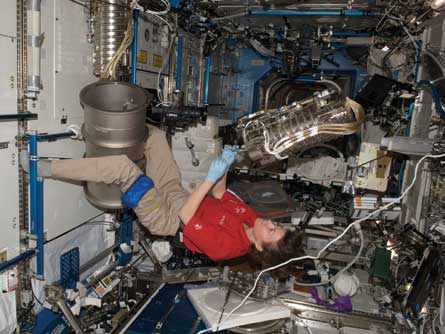Dan Thisdell/London
The European Union has kicked off the "human genome project" of metallurgy, which European Space Agency head of advanced materials and energy research David Jarvis says promises to be as revolutionary in the fight against global warming as the multi-billion dollar push to map our DNA has been in medicine.
Speaking at the Paris air show, Jarvis said the €22 million ($31.7 million), five-year "Accelerated Metallurgy" pilot project promises to start unlocking the mysteries of metal alloys that thousands of years of trial and error and laboratory research have barely begun to reveal.
Just 5% of all possible three-or-more element alloys have been thoroughly investigated, says Jarvis, but an ESA-patented 30s automated process for mixing powdered elements and testing for attractive properties will for the first time make it possible to scour the periodic table for performance "sweet spots".
Promising candidates can then be sent to the International Space Station, where ESA runs the world's only microgravity materials science laboratory, which was delivered to the ISS in September 2009 (see below).
Microgravity research may pave the way to "revolutionary materials" such as the high-temperature superconductors needed to slash energy consumption and boost the performance of electronics. Jarvis stresses the significance of microgravity work on the fundamental properties of materials as being the best or only way forward to a better understanding of how important metals behave at the atomic or crystal level - the viscosity of liquid iron, for example, remains an unknown.
 |
|---|
© NASA |
NASA astronaut Catherine Coleman changing the furnace insert |
One hopeful line of materials research in microgravity will be into nanostructured thermoelectrics, materials capable of scavenging waste heat and converting it to electricity. Jarvis notes that 70% of the energy in diesel or petrol is wasted as heat, with just 20% driving a road vehicle and the rest lost to friction. Sufficient development of heat-scavenging materials could save Europe 2 billion barrels of oil annually.
The potential uses of nanostructured thermoelectrics are vast; just before the Paris air show, Airbus unveiled its vision of the aircraft interior of 2050, which included energy harvesting materials capable of converting passengers' body heat to the electricity needed to power on-board systems.
GLOBAL WARMING
More broadly, Jarvis sees major leaps in materials science as critical to efforts against global warming. The human population is growing, and each person is - rightly - demanding more "services", ranging from artificial lighting to internet access to transport. The only way to cut total energy consumption, and thus carbon dioxide emissions, is to cut the amount of energy needed for each service. And that, says Jarvis, means slashing the weight and boosting the performance of everything from aircraft to mobile phones.
Work is being done in ESA's materials science laboratory on the properties of titanium-aluminide - TiAl - an alloy with half the density of the nickel superalloys now used in jet engine compressor blades. And, adds Jarvis, ISS-based materials work may also be pointing the way to catalysts that outperform the platinum currently used in, for example, automotive catalytic converters, but are "hundreds of times cheaper".
Further underscoring the importance of this work, Jarvis likes the example of some of the first results from the orbiting materials science lab. Better understanding of the solidification performance of aluminium-silicon alloys points the way to more effective recycling of a family of metals of which Europe alone uses 4 million tonnes annually.
"ESA wants to trigger spin-offs and spin-ins with other industries," says Jarvis.
Including development of its microgravity materials laboratory, ESA is spending around €25 million yearly on space-based materials research. In that context, €22 million over five years for the Advanced Metallurgy project is significant, but only a starting point. If early work shows promise, Jarvis anticipates far greater financial support for the project; the human genome project, he notes, began as a $20 million trial but was eventually allocated several billion dollars as its significance became evident.
The European Union has a clearly detailed strategic vision to conserve natural resources, move to low-carbon technologies, increase use of renewable resources and modernise its transport system. Thus, says Jarvis, the alliance of materials, energy and space sciences as a key thread in this push to support a changing society "has top political support".
The quest for technology spin-offs also appears to have top financial support. As ESA director general Jean-Jacques Dordain put it at Paris, a new network of six ESA "business incubators" - two in Germany and one each in Belgium, Italy, the Netherlands and the UK - has attracted bank investment: "If we have the bankers on our side, that is indeed a good sign."
ESA'S ORBITING LABORATORY
The European Space Agency's materials science laboratory is housed in a NASA research rack aboard the International Space Station. It consists of a stainless steel chamber that can accommodate furnace inserts designed to carry out different types of melting and solidification processes; these are an arrangement of heating elements, isolating zones and cooling zones contained in a water-cooled metal jacket. The ISS crew can change the insert depending on an experiment's requirements.
A high temperature furnace insert - capable of 1,600C (2,912F)- is under study.
Samples to be processed are contained in cartridges, including a sample tube and crucible and prepared on the ground at a cost of about €100,000 ($145,000) each. After an experiment is finished, the cartridge is stored until it can be returned to Earth for evaluation.
Source: Flight International


























